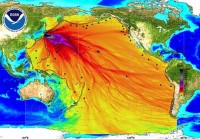The Science March
Compared to our ancestors, we live relatively luxurious lives thanks to the tremendous advancements of science and technology. Every generation seeks to carve out a better life for the next, and an embrace of science is key to allow this to happen. Yet as we make more advances as a society, there seems to be more resistance to scientific fact.
The "March for Science" aims to address these issues. One of many marches to occur since the presidential inauguration, this march seeks to underscore the importance that science plays in our daily lives. From its website: "The March for Science is the first step of a global movement to defend the vital role science plays in our health, safety, economies, and governments."
While the march claims to be non-partisan, it is largely motivated by the new administration's position on climate change. However, this may not be every marchers reason to participate. From my perspective, there is science denial on both sides of the aisle. While many on the right may contest climate change, there are many on the left who may deny the benefits of something like genetically modified organisms (GMOs) or nuclear power's role in mitigating climate change. My personal hope is that the march starts a dialogue between politicians and scientists, to create evidence-based policies that help our society, since misinformation plagues a lot of current discussions.
Take this recent exchange I had with someone who was anti-nuclear. The argument was started because of the high radiation measurements at the Fukushima reactor, and Will Davis', an ANS Cafe writer, response to it. The alarmist anti-nuke was claiming that the levels are so high, the entire Pacific Ocean was contaminated and there were pictures to prove it. To find the picture, one only needs to Google image search "Fukushima Radiation" and the first picture is what they used.
If someone were to show this to you and say, "Look at all that radiation!" you might be a bit alarmed and think the Fukushima situation is out of control. This image has been used by anti-nuclear advocates in argument after argument, so frequently that major news networks would run the image to show to the general public. It doesn't take long, though, for some to look at the picture and notice the scale bar on the right-hand side.
 The map to the right, which has been shown over and over again, is, in fact, tsunami-wave height in centimeters, but is intentionally misused as "scientific evidence" in order to back a false argument. Now, I'm sure that most anti-nuke people would be able to tell you what the lethal dose of centimeters is, but for those living in the real world, it's much more alarming than that. Now more than ever, we see people using scientific findings in a dishonest way, in order to advance an argument. This kind of behavior, I believe, gives many people reason enough not to trust science. Because it is so often misused, it's hard for some to tell fact from fiction. It is our job as scientists, engineers, and mathematicians to call out these sorts of snake oil claims.
The map to the right, which has been shown over and over again, is, in fact, tsunami-wave height in centimeters, but is intentionally misused as "scientific evidence" in order to back a false argument. Now, I'm sure that most anti-nuke people would be able to tell you what the lethal dose of centimeters is, but for those living in the real world, it's much more alarming than that. Now more than ever, we see people using scientific findings in a dishonest way, in order to advance an argument. This kind of behavior, I believe, gives many people reason enough not to trust science. Because it is so often misused, it's hard for some to tell fact from fiction. It is our job as scientists, engineers, and mathematicians to call out these sorts of snake oil claims.
It is clear to me that the denial or misuse of science is not a left or right issue, it is a people issue. The March for Science is a great start to address this issue, and based off the expected attendance, that message should be loud and clear. One of my favorite quotes from astrophysicist Neil deGrasse Tyson on science is, "It's true whether or not you believe in it. That's why it works." For too long of a time we lived in a world where emotion trumped reason, and it's time for that to change. Hopefully the March for Science can be the catalyst.
Editor's Note: Follow on Twitter or get in on the conversation with thehashtag #MarchForScience.

